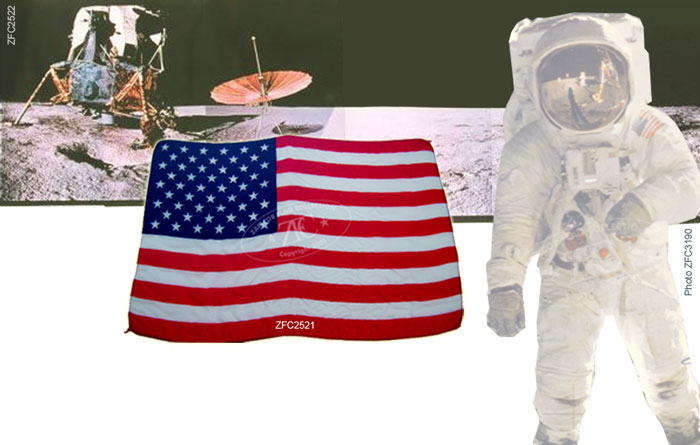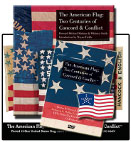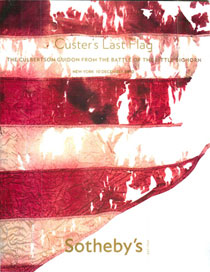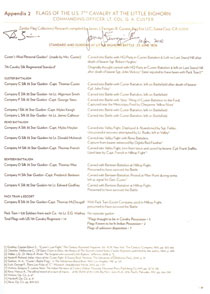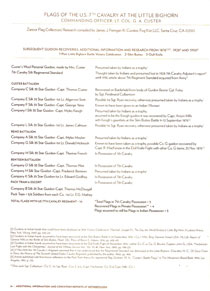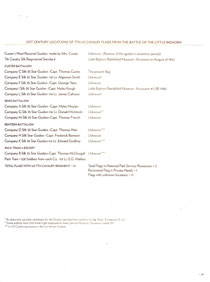The Zaricor Flag collection: Two Centuries of Concord & Conflict
The Zaricor Flag Collection (ZFC), as the noted flag historian, the late Howard Madaus stated, Is the largest most important representation of U.S. and American flags in the world. Containing many important foreign flags, the ZFC is more than a large accumulation; rather it is a dynamic working collection, used for research, exhibition and educational purposes. Read more >>
from the Collector
The ANNIVERSARY OF 1876 THE LITTLE BIG HORN BATTLE is JUNE 25th.
by the Collector: Ben Zaricor & Curator: James Ferrigan
For the first time, since that hot dry day on the high plains of the Montana Territory, a detailed accounting has been compiled of the flags Custer's men took into battle against an overwhelming force of Native American Indians. This rendering is specific to the guidons of the five companies of Custer' Battalion (Companies C,E,F,L and I) detached from Major Reno's Battalion (Companies A, G, & M) and a third Battalion commanded by Capt. Benteen (Companies B, H, & K) plus the Pack Train which consisted of a reinforced company (Company D, plus 5 to 6 men from each of the other companies).
From a total of 14 flags only three flags can be accurately accounted for today. Reading like a baseball score from the beginning to the final accounting of the number today one is struck by the complexity involved in knowing definitively what happened to each flag. ZFC curator, and co-researcher, James Ferrigan, a lifelong vexillologist, draws an abstract map of each flag's disposition before, during, and after the horrific battle. Of special note, Lt. Col. George A. Custer's personal battle flag referred to as a Personal Guidon, which followed him into the battle at the Little Big Horn (1st flag on the list) is believed by historians, and flag experts to be identical to the 3rd Personal Guidon in the Zaricor Flag Collection (see ZFC0489).
These few remaining flags that exhibit the fear, loyalty, and heroism shown by both sides in that epic struggle between two cultures is a poignant testament to the power of flags. An example of one man's attempt to carry out his captain's order to save the flag, illustrates a person's commitment to his duty and fellow comrades, all doomed to die as he himself was, so that this silent witness survives to represent what happened to Custer and his five companies during the chaos that June day in 1876.
Research is ongoing as more information and flags come to light
Whose Flag Is It, Anyway?
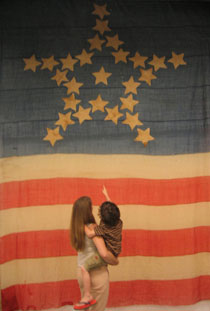
Photo Credit: Star Spangled Banner Flag House Curator
by Ben Zaricor
The American flag packs emotional wallop - a potent symbol viewed passionately across our political spectrum. Much of this passion appears to be rooted in highly personalized, possessive and often misguided perceptions of "ownership".
Many people feel so strongly about "Old Glory" that they are quick to draw lines in the sand and establish their own arbitrary dictates of what constitutes "respect" and what borders on "desecration" - a term itself suggesting something with religious, symbolic power, though the American flag was the first secular national flag. When someone, or some group, violates such artificial barriers, verbal and physical blows may follow as people rush to define and defend "their" flag.
Now we are in yet another phase of America's never-ending, often heated, public debate about the flag and how it "should" be displayed and treated.
That's why actions, for example, calling for an amendment to the Constitution to prohibit "desecration" of the American flag, go to the heart of our country's sense of liberty. I simply do not understand those who want to pass laws limiting our freedom of expression, which has been guaranteed by the Constitution for over two centuries. I do not hold, as others may believe, that our flag needs protection from its people.
Many Americans may not know that, from the Colonial period to 9/11, individual Americans have created and customized the flag independent of any governmental oversight. There is, for example, a long tradition of people incorporating the flag into their clothing. Some people also have added personal elements to their flags, such as writing their names along its borders. The Sons of Liberty added a snake and "Don't Tread On Me"; centuries later, others placed the "peace symbol" in the star field to deliver a specific message in the 1960s, and again in the aftermath of 9/11, the War on Terror and the War in Iraq.
The American flag, and what it symbolizes to people around the world, mirrors our nation's history-from the struggle for independence to today's role as the global superpower. And because no single group "owns" the flag, or ever has, its design and the materials it is fashioned from illustrate the creativity, whimsy and idiosyncratic realities that are embedded in our singular culture.
Because of the powerful emotions bound up in flags, and the fascinating stories tied to them, I decided to become a collector in 1969 when many of my friends would never have dreamed of collecting such things. At that time I saw a young man in a restaurant beaten for wearing a stars and stripes vest. That experience awoke in me a passion to learn the history of our flag, which I discovered was hidden in the old flags.
The creation of a national flag center would provide a permanent, year-round venue where people could view flag exhibits and learn our country's history through these old and torn pieces of cloth. It would provide a forum for discussion of the ideas that influence our character as a nation and a place to participate in spirited educational debates and programs. Today there is no place like The Flag Center where you can see the original flags that tell so much of our country's "sea to shining sea" destiny.
Our flag tells a story of diverse ideas, cultures, personalities, races and political persuasions. It is a story both of differences and of unity. The stars on the blue canton of the flag represent individual states and their union; it is perhaps the most vivid expression of our national motto, E Pluribus Unum - "Out of Many, One"
It is our flag, not the flag from our government. It is something we use in our everyday lives to express ourselves and our political freedoms. When you look at these pieces of American history, you realize they were designed, made and used by people very much like ourselves. This flag belongs to us all.
Ben Zaricor, co-sponsor of the 2003 exhibition in San Francisco, The American Flag: Two Centuries of Concord & Conflict, began collecting flags in 1970 while a student at Washington University in St. Louis, Missouri. With his wife Louise and family, he has assembled more than 2,500 flags, quilts, and other flag related items in the Zaricor Flag Collection. A version of this essay was published in the San Francisco Chronicle on July 4, 2003 pg. 29. A later version of this article appears on Madaus & Smith, The American Flag: Two Centuries of Concord and Conflict, VZ Publications, Santa Cruz, CA 2006, pg. 142

"If it can stand to be flown, fly it... And if you're going to collect, put them up so people can experience them. To see them, that's a kid's dream." Ben Zaricor
Curator's Note
Summer contains Americas "Triple Crown" of flags: Memorial Day, Flag Day, and the nation's birthday, the Fourth of July. In honor of these observances the print and online magazine Robb Report, the definitive authority on collectible connoisseurship, had featured significant flags from the Zaricor Flag Collection.
To commemorate this "flag season" the Zaricor Flag Collection is highlighting the flags mentioned in the article as well as presenting on our flag collection carousel an additional selection of extremely rare and desirable flags as well as invitations to explore a chronicle of the last decade's exhibits and the Heart of the Collection.
On the sidebar please find two items: additional material regarding original research undertaken by the ZFC regarding the disposition of the flags and guidons used over 140 years ago at the 25 June 1876 Battle of the Little Big Horn; and a thought provoking essay, "Whose Flag is it, anyway?"
U.S. 13 Star, 12 Stripe Revolutionary & Early Federal Period Flag Hancock & English
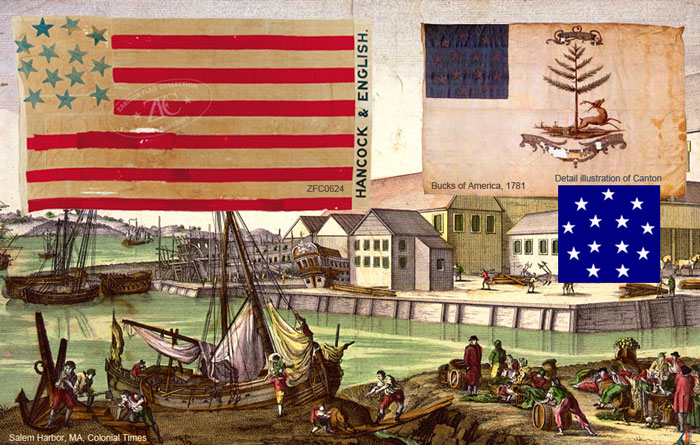
U.S. 19 Star U.S. Northern Abolitionist Exclusionary Flag, 1861 & The American Anti-Slavery Almanac, 1844
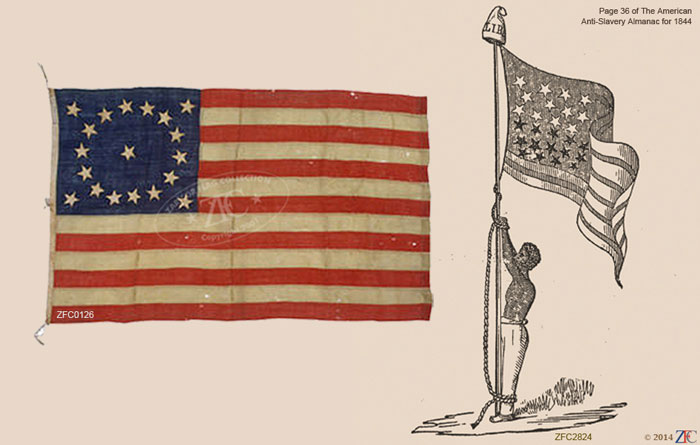
ZFC2824 The black and white stars on the stylized flag, denoting the northern and southern states as "free" and "slave" state. Read More
U.S. 26 Star Grand Luminary "Gildersleeve Meteor" Flag
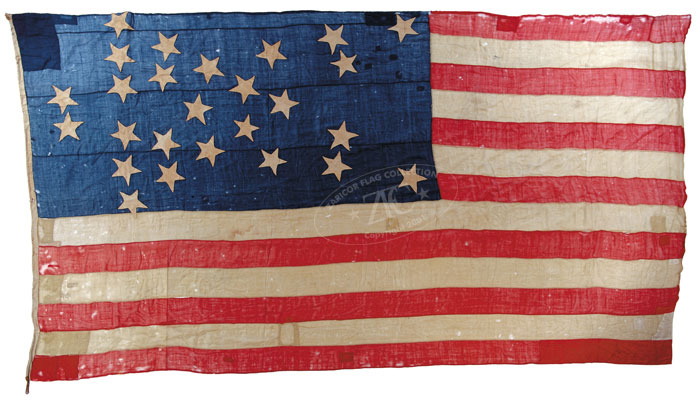
U.S. 28 Star National Color 4th Louisiana

USS Constitution No.1 Ensign, 28-30 Stars
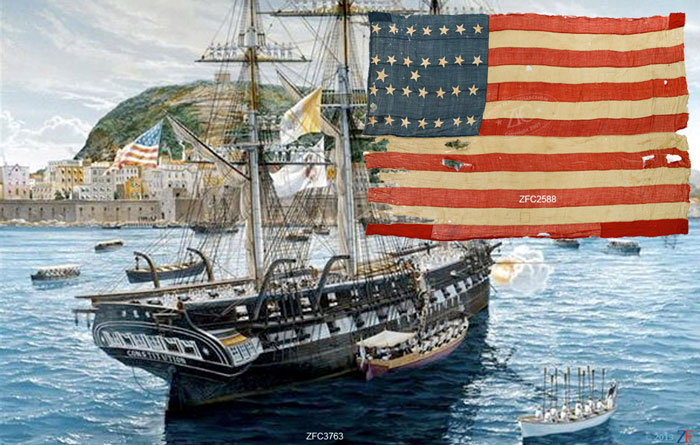
U.S. 31 Stars, 14 Stripes Flag California joins the Union
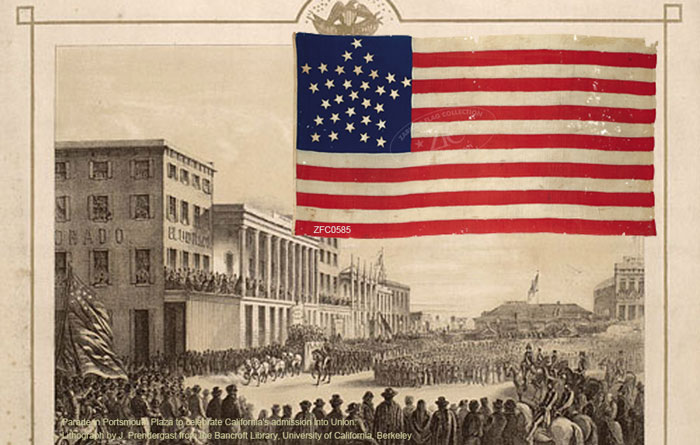
U.S. 32 Stars, 11 Stripes Flag Minnesota's admission into the Union
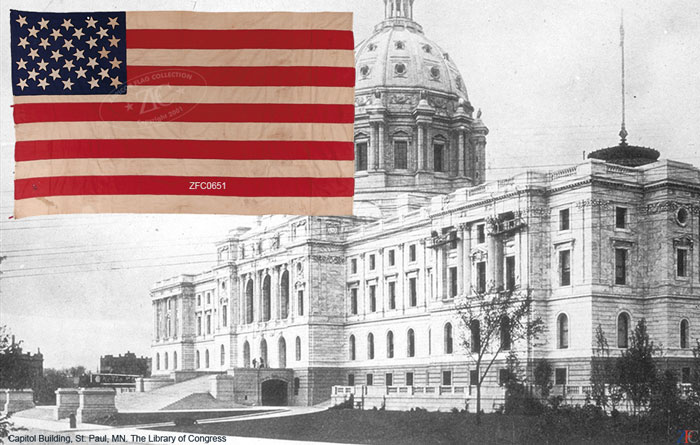
General George A. Custer's Guidons
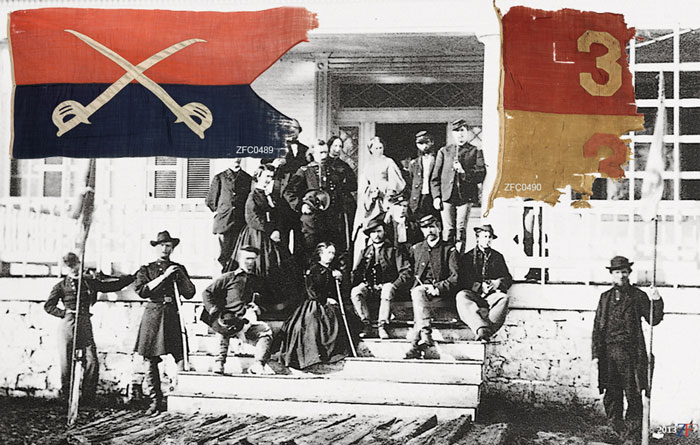
This flag was only flown when Custer was on the field. This was one of Custer's more famous flags, as it served with him in the Civil War while commanding the US 3rd Cavalry Division from 1864-1865. Read More
ZFC0490 General George A. Custer's Headquarters Command Guidon, 3rd Division, Cavalry Corps.
General Custer commanded the 3rd Cavalry Division in 1864 thru the end of the Civil War 1865. This flag served with Custer during this period along side his Personal guidon (see ZFC0489). Read More
ZFC1492 Photograph of General Custer at his Headquarters,his wife and staff.
Photo taken at the M.Y. Mason mansion, Winchester, Virginia, on the 25th of December, 1864. Custer had made this house his headquarters in Winchester. His two guidons are clearly visible in this photo. Read More
U.S. National Regimental Colors
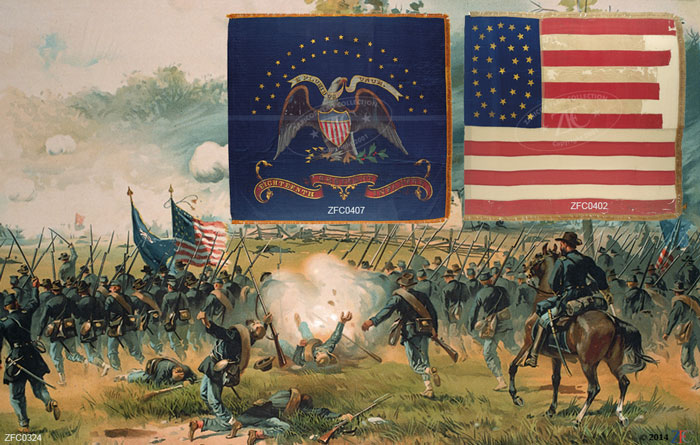
This was the 18th U.S. Regular Infantry's regimental color in the period from 1865 through 1866. In the latter year, the 18th U.S. was garrisoned a Fort Phil Kearny in Wyoming Territory during the "Fetterman Fight" Read More
ZFC0402 U.S. 35 Stars Artillery National Color.
The oral tradition associated with this flag is that it was used during the American Civil war by Major Wilbur Fiske Goodspeed, Chief of Artillery for the 4th Army Corps of the US Army of the Cumberland. Read More
President Abraham Lincoln Funeral & Mourning Flags
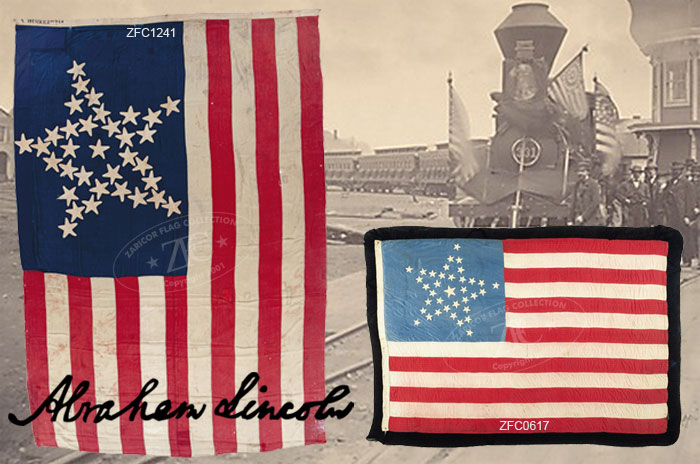
After his assassination a funeral cortege by railroad was planned. At each stop his body would lay in state so that the nation might mourn its fallen martyr. This flag was flying when Lincoln's funeral train arrived at Albany on the tracks of the NY Central Railroad. Read More
ZFC0617 U.S. 36 Star "Grand Luminary" Lincoln Mourning Flag.
This 36 star grand luminary flag's history is rich; it was used as a mourning flag after the assassination of Abraham Lincoln. Read More
John F. Kennedy Presidential Limousine Flags

These flags, which President John F. Kennedy used throughout his 1000 days in office, were on the presidential limousine when his life was taken in Dallas. Read More
ZFC2501 John F. Kennedy Presidential Limousine Flag
The U.S. Presidential Flag always represents an institution, not a specific person. In a monarchy the royal standard symbolizes personal hereditary rights. Our Constitution gives an individual responsibility and rights only for so long as he serves as president. Although separate flags to designate the commander in chief of the Navy and of the Army had existed from 1882 and 1896, a common flag for the president of the United States was not adopted until 1916. Read More
U.S. 50 Star Apollo 14 Flag EVA Moon Flag, 1971
